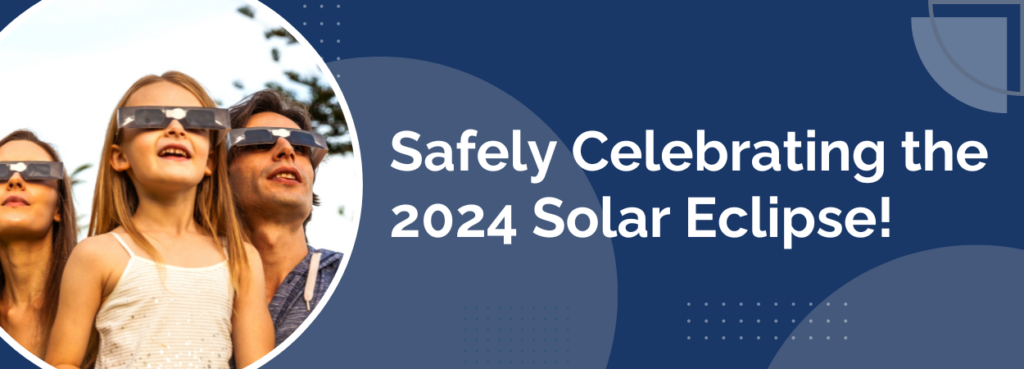
On April 8, 2024, Californians will get the unique opportunity to witness a total solar eclipse! The moon will gracefully pass between the sun and the Earth, casting its shadow for a brief moment of wonder and awe. However, as mesmerizing as it may be, observing a solar eclipse requires caution, particularly when it comes to protecting our eyes.
Keep reading to learn quick, fun facts about solar eclipses and essential tips on how to safeguard your vision during this extraordinary event.
Understanding Solar Eclipses:
Together, the sun and moon transform day into an eerie twilight, unveiling the sun’s corona, a halo of plasma surrounding the sun.
Fun facts:
- Solar eclipses are relatively rare events. While they occur somewhere on Earth approximately every 18 months, the chance of witnessing one from any specific location is much lower.
- The solar corona, the sun’s outer atmosphere, is only visible during a total solar eclipse. It appears as a delicate halo surrounding the obscured sun, revealing intricate streamers and loops of plasma extending millions of miles into space.
- During a total solar eclipse, temperatures can drop noticeably, creating a brief moment of chill in the air as the moon blocks the sun’s rays.
- Animals can get a bit confused during a solar eclipse. Birds might think it’s time to sleep because it’s getting dark, and nighttime animals may make a short, confused appearance.
- The shadow cast by the moon during a total solar eclipse races across the Earth’s surface at an astonishing speed. It can travel at up to 1,500 miles per hour (2,414 kilometers per hour), covering vast distances in just a matter of minutes as it sweeps across the landscape.
Safety Precautions:
Viewing a solar eclipse without proper eye protection can cause permanent eye damage or even blindness. The intense light from the sun can burn the retina, leading to solar retinopathy, a condition characterized by irreversible vision loss.
Top 5 Recommendations for Solar Eclipse Eye Safety:
- Use Certified Solar Viewing Glasses that meet the ISO 12312-2 safety standard. These glasses are specifically designed to block harmful ultraviolet, visible, and infrared radiation while allowing you to safely observe the sun.
- Never look at the sun through binoculars, telescopes, or camera lenses without appropriate solar filters. Doing so can magnify the sun’s intensity, increasing the risk of eye damage.
- If you don’t have access to solar viewing glasses, you can still experience the eclipse safely using a pinhole projector. Simply poke a small hole in a piece of cardboard and let the sunlight pass through it onto a surface, such as another piece of cardboard or the ground. You’ll see a projection of the partially eclipsed sun without risking your eyesight.
- Keep a close eye on children and pets during the eclipse to ensure they don’t inadvertently look at the sun without protection. Supervise their activities and educate them about the importance of eye safety.
- If you’re observing a partial eclipse, it’s safest to watch from the shade or indoors. Even though the sun may appear partially covered, its rays remain potent enough to cause eye damage.
Where to Get Solar Eclipse Safety Glasses:
When obtaining solar eclipse glasses, always ensure that they are certified safe for viewing the sun and meet the ISO 12312-2 safety standard for viewing the sun. Never use regular sunglasses or improvised methods to view a solar eclipse. Specific solar eclipse safety glasses, can be found:
- Online Retailers (Amazon*, Walmart*, and specialty astronomy retailers)
Remember not all glasses are created equal – be sure to check they meet the safety standard if buying from an online retailer. - Local Science Centers and Planetariums
- Schools, colleges, and universities
- Community Events (libraries or local astronomy clubs)
- Government Agencies (NASA or national parks)
Whether you’re witnessing a total eclipse or observing a partial one, remember to prioritize your eye health and safety.








